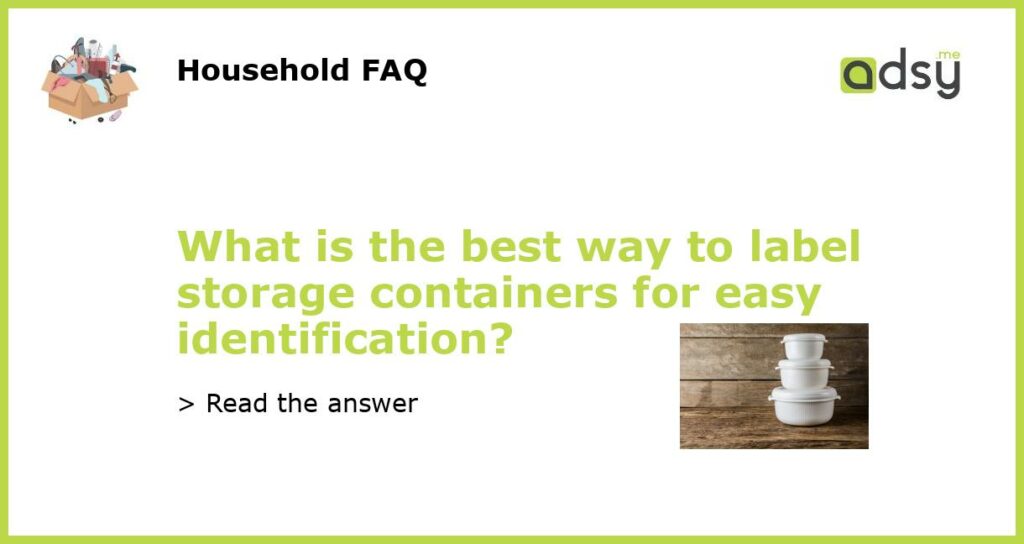Choosing the Right Labeling Method for Storage Containers
When it comes to organizing and identifying storage containers, finding the right labeling method is essential. Whether you are organizing items in your home, office, or warehouse, a well-labeled storage system can save you time and effort. However, with so many labeling options available, it can be challenging to determine which method is best for your needs. In this article, we will explore some popular labeling methods and help you decide which one is the best fit for your situation.
Written Labels
One of the simplest and most common methods of labeling storage containers is using written labels. This method involves writing the contents or category of each container directly onto the container itself or on adhesive labels.
Pros:
- Easy and inexpensive
- Flexible – can be applied to any type of container
- No need for additional equipment
Cons:
- Labels can fade or become illegible over time
- Handwriting may be difficult to read for others
- Can be time-consuming if you have a large number of containers
If you choose to use written labels, it is important to use a permanent marker or label maker with durable adhesive labels to ensure the labels remain legible for an extended period.
Color-Coded Labels
Color-coded labels are an excellent option for organizing storage containers based on categories or departments. This method involves assigning different colors to specific categories, such as red for electronics, blue for office supplies, or green for kitchen utensils.
Pros:
- Visually appealing and easy to spot
- Quickly identifies the category of each container
- Reduces the need to read labels
Cons:
- Requires purchasing color-coded labels or labels of different colors
- May not be suitable for individuals with color blindness or visual impairments
Color-coded labels are particularly useful in large storage areas where quick identification is essential. You can even create a color legend or key to help others easily understand the system.
Barcode Labels
If you are dealing with a large quantity of storage containers or need a more advanced labeling solution, barcode labels might be the best option for you. Barcode labels are printed with unique codes that can be scanned using a barcode reader or smartphone app, providing instant access to the inventory or detailed information about the container’s contents.
Pros:
- Provides accurate and detailed inventory information
- Reduces the chance of human error in identification
- Efficient for large-scale storage systems
Cons:
- Requires purchasing barcode labels and a barcode reader or smartphone app
- Initial setup may be time-consuming
- Not ideal for small-scale storage systems or occasional use
Using barcode labels can be particularly beneficial for businesses with extensive inventories or warehouses. It allows for accurate tracking and simplifies the process of locating specific items quickly.
Digital Inventory Management Systems
For businesses or individuals dealing with a vast number of storage containers and items, using a digital inventory management system can be a game-changer. These systems use barcode labels or RFID (Radio Frequency Identification) tags to track and manage inventory digitally.
Pros:
- Provides real-time inventory tracking
- Streamlines inventory management and reduces manual labor
- Enables efficient searching and locating of specific items
Cons:
- Can be costly to implement and maintain
- Requires training on the system
- May not be necessary for small-scale storage needs
Digital inventory management systems are ideal for businesses with complex inventory needs, multiple storage locations, or large-scale operations. They offer advanced features such as automated alerts for low stock levels or expiring items, enabling more effective inventory control.
Combination Labeling
Depending on your specific needs and storage setup, a combination of labeling methods may be the most effective solution. For example, using color-coded labels in conjunction with written or barcode labels can provide the best of both worlds.
By combining different labeling methods, you can create a customizable system that suits your requirements. For instance, you can use written labels for basic identification, color-coded labels for quick categorization, and barcode labels for detailed inventory management.
Conclusion
Choosing the right labeling method for storage containers depends on factors such as the size of your storage system, the nature of the items being stored, and your budget. Whether you opt for a simple written label, color-coded system, barcode labels, or digital inventory management, the goal is to create an organized and efficient storage system that saves you time, minimizes errors, and maximizes productivity.






